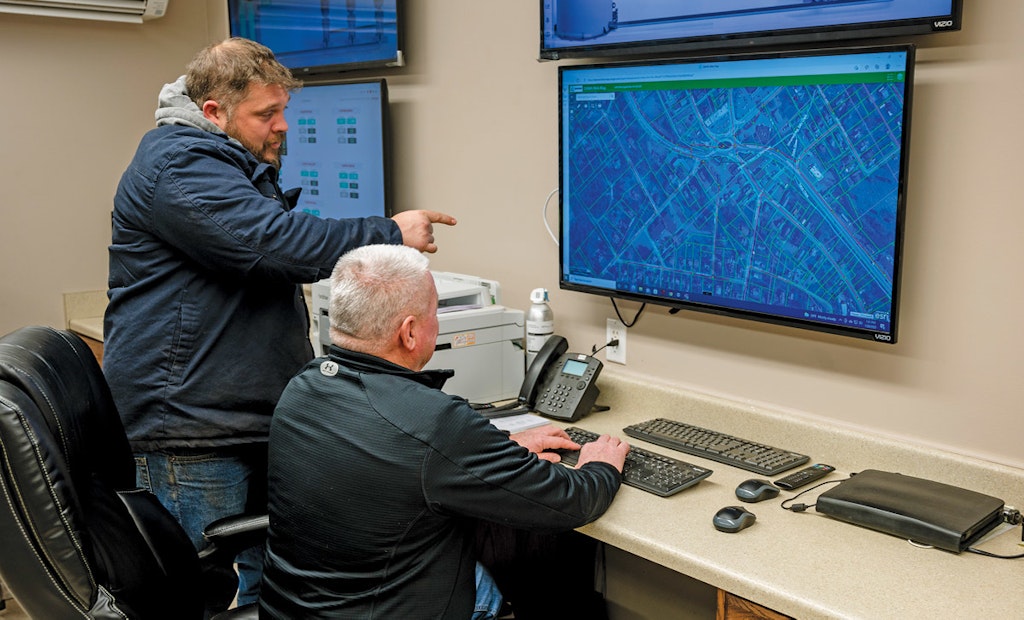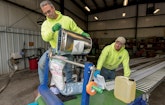
DAMA Wastewater Supervisor Ed Hann (right) and Assistant Wastewater Supervisor A.J. Harris use GIS to look over the collections system grid. The collections system includes approximately 100 miles of gravity sewer lines ranging in size from 6 to 30 inches in diameter.
Interested in Manholes?
Get Manholes articles, news and videos right in your inbox! Sign up now.
Manholes + Get AlertsThe Dallas Area Municipal Authority in northeastern Pennsylvania is in the midst of a $4 million manhole-rehabilitation project aimed at significantly reducing stormwater infiltration and inflow in its sanitary sewer system.
The project is designed to stop sewage overflows that primarily occur at the authority’s main pumping station during heavy rains. And it’s coupled with programs designed to find illegal sump-pump connections to sewer laterals and failing lateral lines that add to I&I woes in the system, mostly built in the 1970s.
Fixing the problem is critical to economic growth in the area, a five-municipality area known as the Back Mountain, because it would ease limitations on residential and commercial development imposed by the Pennsylvania Department of Environmental Protection (PaDEP). In 2017, the agency issued an order that effectively banned additional connections to the sewer system, he says.
“While a negotiated consent order and agreement now allows for some connections as work to alleviate the I&I problem continues, future growth in the Back Mountain is contingent upon correcting the problem,” says DAMA Executive Director Tom Keiper. “This is the largest single project to alleviate I&I that we’ve ever undertaken.”
The flooding occurs about five to 10 times a year and lasts anywhere from an hour to a couple of days. The main culprit? Roughly 2,250 of the system’s 2,500 manholes that leak because they rest below pavement grade. Most of them also feature covers with holes in them that allow stormwater entry, Keiper says.
“That was the technology at the time,” he notes. “They thought the holes were necessary for better drainage and venting. Plus they weren’t as concerned about I&I back then.”
Furthermore, many of the brick manhole chimneys are starting to fail, which exacerbates the I&I issue. Because the area’s terrain is so hilly, the depth of the chimneys fluctuates from 3 inches to 3 feet, says Ed Hann, wastewater supervisor.
The project started in spring 2021 and is expected to conclude this fall. The authority floated municipal bonds to fund the manhole project, as well as upgrades to the main pumping station and a 2.8 million-gallon equalization tank. The addition of a second equalization tank is also a possibility, Keiper says.
Wastewater services
Based in Shavertown, north of Wilkes-Barre, the authority has 10 employees and serves about 8,600 households in a roughly 46-square-mile area that includes five boroughs and townships in Luzerne County. DAMA manages and maintains about 100 miles of gravity-fed sewers, made primarily from 6- to 30-inch-diameter clay pipe; a nearly 6-mile-long interceptor line, made from 20- to 30-inch-diameter concrete pipe; and 16 remote pumping stations.
The main pumping station handles an average daily flow of 3.5 million gallons per day. During heavy rains, peak flow reaches 8 mgd.
The pumping station sends waste via a 4-mile-long, 18-inch-diameter ductile iron, cement-lined force main to a treatment plant operated by the Wyoming Valley Sanitary Authority. The authority used to own a treatment plant, but it was abandoned in the early 1990s because it required extensive upgrades the authority couldn’t afford, Hann says.
Heavy snow melt in spring, combined with rain, also produced overflows. The overflow is chlorinated and screened as it passes through a paved channel that drains into Toby’s Creek. The creek eventually flows into the Susquehanna River and then into Chesapeake Bay, hence PaDEP’s concerns, Hann notes.
“We try to minimize the effects of overflows as best we can,” he says.
To determine the sources of the I&I, the authority hired a company to install Flo-Dar flow meters from Hach USA in 12 manholes — one in each of 12 designated drainage basins in the utility’s service area. A consultant in Pittsburgh then analyzed the results.
“Lo and behold, all 12 basins contributed to the problem,” Keiper says.
Wrapping it up
The first step in the manhole-rehab process is removing the brick chimneys. The general contractor on the project, Sikora Brothers Paving, is using hydroexcavation to expose the chimneys and minimize pavement destruction. Workers then rebuild the chimneys with concrete rings to bring them up to grade.
Next, crews enclose the rebuilt chimneys with Wrapidseal from CCI Piping Systems. It’s essentially a heat-shrinkable sleeve designed to conform to irregularly shaped structures and seal them with an impermeable exterior barrier. It also provides structural integrity and accommodates structural movements.
“To shrink the wrap, you heat it with a propane torch,” Hann explains. “Instead of sealing it with an epoxy coating from the inside, for example, where it’s subject to freeze and thaw cycles, this product wraps around the outside and stops water from coming in altogether.”
The rehab concludes with the installation of a bolt-on lid with O-ring seals that provide a water-tight seal between the frame and the new manhole lids. Made by E.J. Manholes, the lids feature closed pick holes that limit water entry.
Sikora Brothers is rehabbing 1,750 manholes and DAMA employees are handling the remaining 500.
“We’re concentrating on manholes located on improved surfaces, where they’re at a level where water can run into them,” Hann explains. “We’re not as concerned right now with the remaining right-of-way manholes that stick up above the ground.”
Self-sufficient operation
The authority decided to rehab the 500 manholes with its own employees because it reduced project costs. This decision reflects an overall operating philosophy that favors self-sufficiency and cost reductions wherever possible.
“For anything that costs more than $20,000, we have to put it out for bid and pay prevailing wages set by the state,” Keiper says. “So sometimes it’s more advantageous to do work ourselves. But in this case, we couldn’t do that many manholes that quickly, so we hired a contractor.”
The authority also cleans, inspects and rehabilitates/repairs its sewers. To do so, DAMA has invested about $1.4 million in a camera truck outfitted by RapidView IBAK; a Vactor 2100 combination sewer truck featuring a 12-cubic-yard debris tank, 1,200-gallon water tank and a vacuum pump made by Roots (a brand owned by the Howden Group). The utility also owns a steam-cured pipe lining system and a lateral-lining system for wye and tee fittings from Trelleborg; a robotic lateral-reinstatement machine from Dancutter A/S (a Halma company); a robotic cutting machine manufactured by Schwalm Robotic; and a RIDGID SeeSnake pipeline-inspection camera.
“We save a lot of money by doing things ourselves,” Hann explains. “Plus, it comes down to timing, too. It can be very time-consuming to put projects out for bid. And contractors aren’t always available when you need them. And when they are available, rain or bad weather might stop them from working.
“So we figure it’s more cost- and time-effective to handle things ourselves, on our own schedule.”
Making progress
As of mid-January, nearly 1,100 manholes have been rehabbed. Hann says Sikora Brothers is rehabbing an average of 12 to 15 manholes per day. However, workers started with remote manholes on lightly traveled roads, so he expects that average to drop when they start working on much more heavily traveled roadways, which will decrease productivity.
Nonetheless, Keiper says initial indications show the project is already having a positive effect.
“It seems like the few overflows we’ve had recently aren’t as long in duration,” he says. “But we still have a long way to go.”







